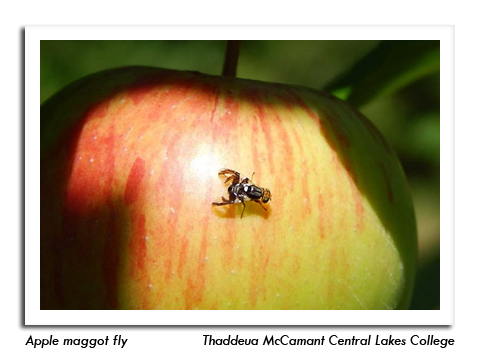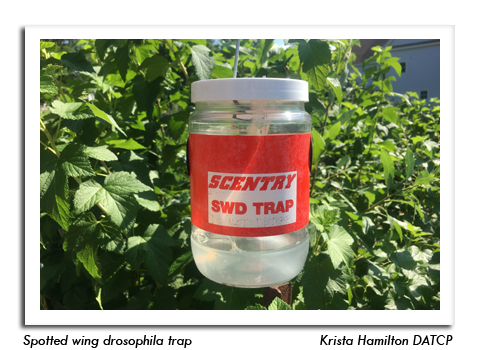
 |
|
|
Fruits
Volume 65 Number 9 Date 06/25/2020 APPLE MAGGOT - Emergence of flies is expected before the end of the month in southern locations. Apple maggot traps should be placed this weekend (June 27-28) in perimeter trees adjacent to wild hosts to capture the earliest adults. Orchards with a history of AM damage should also set a few traps in early-ripening cultivars in the orchard interior. A density of one trap every 200-300 feet along the perimeter and three traps per 10 acres within the orchard is recommended. The economic threshold for apple maggot control is one fly per unenhanced trap per week or five flies per enhanced trap per week. JAPANESE BEETLE - Adults were observed on ornamentals and in field crops this week, suggesting that Neem oil repellant sprays or neonicotinoids must be applied soon, while populations are low and the beetles are beginning to migrate into orchards. Early signs of visible feeding damage warrant application of a repellent like neem oil or a full rate application of a neonicotinoid such as Assail (acetamiprid), Belay (clothianidin), or Alias/Montana/Wrangler (imidacloprid). Neem oil is appropriate for organic systems and effective when applied repeatedly. PyGanic is another organically acceptable method for immediate contact control, but the material dissipates quickly if applied during the day. A third organic option is Surround WP (kaolin clay) which deters both Japanese beetle and apple maggots, although its efficacy against Japanese beetle is inconsistent. If populations are widely dispersed, it is advised to treat the entire orchard rather than spot-treating only the heavily infested blocks. Japanese beetle shows a strong preference for Honeycrisp. CODLING MOTH - Most orchards have accumulated about 450-600 degree days since the May 24 biofix and first-generation egg hatch has peaked. Locations with a later June 1 biofix are at 350-500 degree days. After last week's general decline in CM flights, several orchards reported another round of higher counts June 18-24, with economic captures of five or more moths per trap per week reported from 9 of 24 cooperating locations (38%). A second larvacide is often applied at peak egg hatch depending on how large the flight is, and sometimes a third or even a fourth larvicide treatment may be necessary. Apple growers are advised to continue monitoring degree days and CM trap counts until 700 units (modified base 50°F) have accumulated from the spring biofix to determine if additional late flights require treatment. If any traps exceed the 5 moth per trap per week threshold within the next two weeks, John Aue suggests treating those as a "B" hump or a "mini-biofix" where a larvicide is applied after another 250 degree days have accumulated. SAN JOSE SCALE - Crawlers are emerging from beneath scales in southern and western Wisconsin orchards. Known hotspots, areas of suspected high SJS pressure, can be monitored using black electrical tape on scaffold branches. The tape should be wrapped adhesive side-down, and a thin layer of petroleum jelly applied to the outer side of the tape. Captures of 10-15 crawlers on several taped branches over the course of a few days, or 10 crawlers on one tape, may warrant control. Treatments should be applied once the yellow crawlers are active, but before their white, waxy coverings (white cap stage) start to form on the leaves and branches. Conventional products for summer control include Esteem (pyriproxyfen) or Movento (spirotetramat). Options for organic growers are summer oil and encouraging biological control. DOGWOOD BORER - This clearwing moth began appearing in pheromone traps two weeks ago. The traps do not indicate the need for control, but instead signal when to begin scouting for evidence of DWB larval feeding, such as frass around the graft union of trees. DATCP cooperators should be aware that the commercially available DWB pheromone lure attracts several native clearwing moth species, therefore accurate identification is important. The correct height for DWB traps is 3-4 feet above the ground. Scouting for this pest is especially important for orchards with new trees planted in the last five years. OBLIQUEBANDED LEAFROLLER - Larval offspring from the first moth flight are emerging across the southern half of the state. The small, newly-hatched caterpillars are controlled by most products applied for codling moth (except granulosis virus and mating disruption), but scouting terminals and younger trees is still required to determine if codling moth sprays have effectively reduced OBLR populations or if additional measures are needed to prevent fruit damage. Sampling for fruit and foliar feeding should begin about a week after the first moths are captured in pheromone traps. John Aue of Threshold IPM Services recommends an application for any OBLR catches over 10 moths per week. SPOTTED TENTIFORM LEAFMINER - Moths of the second flight are emerging in greater numbers, with pheromone trap counts ranging as high as 957 per trap and averaging 122 per trap. This is up markedly from last week's average of 13 per trap. Peak moth activity should occur by mid-July across southern and central Wisconsin and a week or two later in the southeastern, east-central and northern areas. Apple orchards with populations exceeding one mine per leaf or a history of STLM damage are candidates for control of second-generation larvae. SPOTTED WING DROSOPHILA - Fly emergence began in western Wisconsin by June 21. The first capture of SWD adults in survey traps should be viewed as an early warning to fruit growers to increase monitoring efforts and make preparations for SWD management. This invasive pest is particularly challenging for organic growers due to the limited number of organically approved and effective insecticides. The recently developed guide "Management Recommendations for Spotted Wing Drosophila in Organic Berry Crops," provides a list of non-chemical and insecticide approaches to protect berry crops against SWD. Controlling SWD requires a rigorous, persistent and diverse management plan. -- Krista Hamilton, DATCP Entomologist 


.jpg)
.jpg)

|
|
|